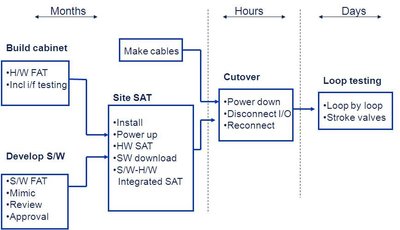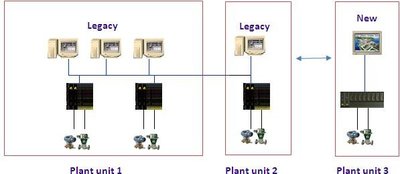Minimising risk in a system migration project: 8 steps to success
All control system projects include the same basic components: scope definition, hardware build, software implementation, test, commission. But system migration projects have a very different risk profile to greenfield projects, which means the project management of the two types is quite different.
In one of its recent white papers, ARC reported:1
“We estimate that there are $65 billion worth of installed process automation systems in the world today that are nearing the end of their useful life-cycle, which in many cases can exceed 25 years.”
This represents a major challenge for plant owners; how to maintain their competitive advantage with ageing equipment. The challenge is exaggerated due to the fact that the skill set required to build their control system is different to that required to upgrade or migrate it.
There is an attitude that migration projects only have downsides. Many companies think “today my plant is running and the best I can hope for is that it continues to run after the migration”. While this may be a little pessimistic, it highlights the key issue around migration jobs - risk!
So what are the differences between migration and greenfield projects?
First - the good news
There are some aspects of migration that make them easier than greenfield projects. Firstly, with years of experience you know how your process works. You are familiar with the control strategy required and are aware of the important control functions. Secondly, your workforce is experienced, unlike the new staff you are likely to have on a greenfield start-up. In addition, your migration project is likely to be the key task of the shutdown. Although the work may involve other process improvements, you may be less dependent on civil and mechanical schedules than on a new plant. Finally, you can often gradually execute the migration one step at a time. This can not only help spread cashflow, it can also reduce risk.
Now the bad news
How can you be sure the cutover will be complete in the shutdown window (or even cutover hot)? How can you be sure the control strategy will be as good (or preferably better) as it was in the legacy system? How can you be sure operators will be comfortable with the new system? How can you be sure there are no hidden traps and ensure costs will be controlled?
Below are some suggestions on how to minimise these risks.
Have a good plan
Firstly, to protect the schedule, you must have good plan. Not just a Gantt chart, but a full list of activities and regular progress meetings with your supplier. Clearly identify the risk areas up front and have a plan to mitigate any risks. For example, if you are unsure about the quality of your documentation, discuss the implications for schedule and cost. It may be worth extending or delaying to ensure drawings are accurate. Clearly identify what activities can be performed during the shutdown and what can be completed in advance. Even the shortest shutdowns can usually be accommodated with detailed planning.

Have a clear specification
Secondly, to protect the project budget, have a clear specification. Resist the temptation to simply take the existing configuration as the specification document. It can be used as the basis for writing a functional design specification (FDS) but a clear scope is required. Remember, during testing you will need to sign off on the functionality - the safest way is to test against a complete FDS.
Allow time from your ‘day job’
Also, as a plant engineer, don’t underestimate the input you will be required to give to the project. Delays in clarifying or supplying missing data will likely have significant impact on the schedule and budget. The new system vendor will make their best efforts to interpret the requirements, but be prepared to dedicate time to the project. Don’t plan on doing your current ‘day job’ full time during the project.
Stage the project over separable portions
If at all possible, you should try to stage the project over a number of smaller separable portions. Starting with a less complicated portion of the project can reduce risk by teaching lessons about the new system and your migration strategy. It can give the opportunity to re-evaluate your approach. One option is a ‘vertical migration’ split, where a standalone portion of your process (for example, the water treatment plant) is fully migrated as the first stage. A vertical migration has advantages on plants where shutdown time is limited. Consideration needs to be given to any control interaction required between the legacy systems and the new systems.
‘Horizontal migration’ splits are also sometimes employed, where initially only a single control layer (for example, all workstations) is migrated. Some vendors have solutions allowing various different levels of the legacy system to remain and communicate with new system. Solutions retaining the terminations to eliminate rewiring are the most common. Staged migrations, however, inevitably cost more than a single-step migration; this extra cost needs to be weighed up against any reduced risk they can deliver.

Don’t try to keep old strategies
Avoid trying to make the new control system look and act exactly like the old one ‘to make it easy for the operators’. You will be putting a 20-year-old strategy into a modern system and inevitably be missing out on many new developments in control system technology. Even worse, the extra effort required to make the new system look like the old one will likely add complexity and risk for the operators. Talk to your vendor and ask for their help in the best way to implement your specification into their control system.
Involve the operators
The best way to get the operators to accept the new system is to involve operators in the project. If practical, get them trained on the new system well before the changeover, so they know what they will be working with. Ask for their help in designing the screen layout, operator interface, graphic displays etc.
Take the opportunity for process improvement
Take the opportunity to improve your plant; try and get some upside beyond simply avoiding obsolescence. Perhaps you can implement a new control algorithm to improve the efficiency of a process unit, perhaps improve plant availability and reduce maintenance costs by taking advantage of the ‘smarts’ inside modern field devices. Or at least try and position your plant for the future by planning to take advantage of new technologies like wireless field devices, remote access, bus technologies etc.
Be prepared for some things to go wrong
Finally, be prepared to accept some things may go wrong. Even with the best planning there are usually some surprises in migration jobs. Experience has shown that the owner-supplier relationship is the best indicator of how well these issues get resolved. Find a vendor you feel comfortable with and that you can think you can develop a good relationship with. If you don’t have an existing relationship with a vendor, ask for references. Look for specific system migration project experience.
|
References: |
Encore Tissue improves plant reliability with new DCS
An Australian toilet paper and paper towel manufacturer needed a modern DCS solution that would...
Data-driven insights: how AI is transforming industrial processes
Although most of the underlying mathematics of control systems stems from the 1960s, it has only...
From smart to vulnerable: The hidden costs of the digitalisation of utilities
For Australia’s critical infrastructure sectors proactive investment in cybersecurity is no...







